VI. Analysis of the 2MASS Second Incremental Release Catalogs
4. Completeness and Reliability
d. Extended Sources in the Galactic Center
vi. Source Density Threshold For GALWORKS
GALWORKS raises its extraction thresholds as the confusion noise in an area increases, which decreases the total number of extended sources extracted from each scan that are put into the Extended Source Database. However, at some point the density is so high that GALWORKS itself breaks down, and produces a large number of meaningless extractions.
We have analyzed this problem using two approaches. The first, from the scan database, shows that at a density around 4.70 - 4.80, the number of sources increases so rapidly that the GALWORKS results are probably useless. The second, from the XSC, examines whether the density values are correctly computed at very high densities, and finds that there is indeed a slight turnover in computed density, as T. Jarrett has previously reported. Hence, it is necessary not only to apply a density cut to the catalog, but also an areal cut to make sure that areas with very high source density are tossed.
Analysis of the Scan Database
We searched the scan database on 1999 Dec 21 for scans with quality > 5 that had a center galactic latitude within 15° of the Galactic Plane. We plotted the number of extracted sources per scan vs. the maximum density in the scan. There were 4,571 scans with a non-null density value, and 2,743 scans that had a null value for the reported density. We do not know why any scans had a null value reported.
Figure 1 shows that GALWORKS operates well up to a density of 4.70 - 4.80, and beyond those values should probably simply be turned off.
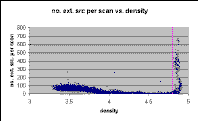
|
| Figure 1 |
The pink line is density_max = 4.80. See also Figure 2, with an expanded scale.
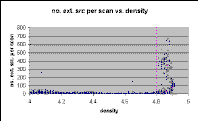
|
| Figure 2 |
The density appears to be a reliably-computed parameter, since it correlates well with galactic position, as shown in Figure 3.
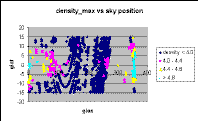
|
| Figure 3 |
The scans with null values for density appear to be a subset of scans that did not have their density values populated in the database are shown in Figure 4.

|
| Figure 4 |
T. Evans reports that the database managing software did not always read the file containing these values. The version that does was delivered on 1999 May 14, and even then not all nights actually had the file (depending on processing date).
Analysis of the XSC
We searched the XSC on 1999 Dec 21 for all sources with |glat| < 10° and |glon| < 70°. We show the sources separately with density above and below 4.8 in Figures 5 and 6.
The number of sources per unit area declines as the Galactic center is approached, but then increases again near the Galactic center. (See especially the high source counts at glon = 70° and glat = 10° and the decline toward lower latitudes at that glon.) The increase near the Galactic center clearly begins at density values just under 4.8, as seen by the "ring" of sources just above the Galactic center in the density < 4.8 plot.
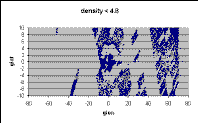
|
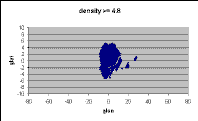
|
| Figure 5 | Figure 6 |
T. Jarrett has now looked at 20% of these sources and they turn out to be nearly all multiple stars (over 99% of the 2,000 sources examined are clearly triple+++ sources).
Furthermore, the computed density value turns over at the very high densities at the Galactic center, as seen by the appearance of the Galactic center in the density < 4.8 plot. Figure 7is a histogram of the density values for the Galactic center sources in the density < 4.8 plot shows that the computed density turns over gracefully, since the histogram is highly peaked at values near 4.8.
This histogram shows that the number of sources starts to turn up significantly past values of 4.7, so this is probably where the catalog should be cut for this Release.

|
| Figure 7 |
We made a search of the entire Working Extended Source Database on 1999 Dec 28 and found no sources in areas with density > 4.7 outside of glon ± 10° and glat ± 6°, and hence, apparently all such high density areas are confined to the region near the Galactic center.
Hence, we propose that the algorithm to use to exclude these largely meaningless sources from the XSC is to simply use a geometric cut on the XSC and eliminate sources found close to the Galactic center. One algorithm to do so is to exclude a box of ±5° glon and ±6° glat, and then two triangles defined by the line connecting (glon,glat) values of (5,6) - (40,0), and the symmetric lines corresponding to that line. Another algorithm is to exclude an ellipse with semimajor axis of glon = 40° and semiminor axis of glat = 6°.
Figure 8, showing sources in areas with density > 4.7, clearly defines the problem area.
The two exclusion areas defined above both work equally well in capturing the area defined by those sources. Figure 9 showing sources in areas with density < 4.7 looks free from artificial increases in the number of extended sources.
T. Jarrett has fit an ellipse to the area with density > 4.7. The ellipse has a semi-major axis of 12.8° in glon and a semi-minor axis of 6.0°, an axis ratio of 0.47.
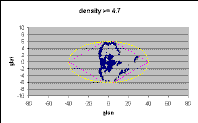
|
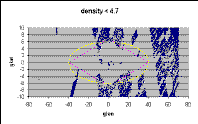
|
| Figure 8 | Figure 9 |
[Last Updated: 2000 Jan 6 by T. Chester. Modified 2000 Jul 31 by S. Van Dyk.]
Return to Elimination of False GC Sources from XSC.